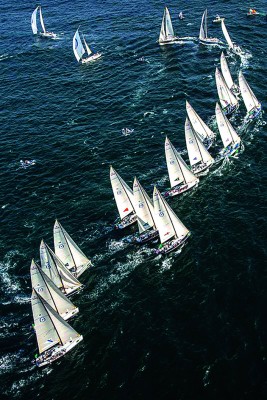The choice of a bear away or a gybe set spinnaker hoist can be pivotal to a good race result. Jonty Sherwill outlines the basics, while match race champion Ian Williams gives his tips for when to go for the gybe set
There is always a temptation to keep things simple on the racecourse and opt for a bear away spinnaker set. However, some basic compass and tide checks can reveal how much can be gained by a gybe set instead. Comparing the course to steer with the true wind direction is the basis of the calculation.
A good rule of thumb is to point the boat head to wind near the leeward mark and sight up to the windward mark. If the bow is pointing to port of the mark, it will be predominately a starboard gybe run. If it’s pointing to starboard of the mark it will be a long port gybe.
If the course to steer to the leeward mark is within 10° of a square run a bear away set is usually preferable. The spinnaker pole can go up early, allowing a quicker hoist. This helps to maintain boat speed, particularly in light airs.
If the run is badly skewed or there is strong tide running across the course then a gybe set can create a big gain.
For most boats with symmetrical spinnakers, the decision about whether to bear away or gybe set must be made well before the windward mark and early enough to allow the crew to switch the gear – hauling round the spinnaker sheets and halyard before clipping the spinnaker on.
By contrast, for asymmetric boats that plane downwind at high angles and can hoist their kites on either side it can be a split-second decision and will be driven by where the best wind pressure can be found.
With gybe sets there are always risks, including being collected by upwind boats approaching the windward mark, so it is vital to assign some crew to keep a watchful eye out during this busy manoeuvre.
1. Calculate the risk
In most boats there is a price to pay for doing a gybe set compared with a bear away set and then an early gybe owing to the complication of a gybe set. So, it is important to understand both your boat and your crew in different conditions in order to assess whether the gybe set is worth both the cost in terms of distance and the risk of a boat handling error.
2. Factor in compression
When the fleet is very compressed at the top mark, there is often an additional cost to a gybe set associated with sailing back through the bad air of the upwind or offset leg boats. The nearer the front of the fleet you are the more this costs, so you will often see the leaders continuing on and the boats near the back gybing away.
This tends to be more costly in asymmetric boats as the angle out of the gybe takes you closer to the other boats and often these boats are more sensitive to dirty air than boats with symmetrical spinnakers.
3. Assess the long gybe
As part of your preparation for the run, you should always make an assessment of which is the long gybe before you get to the windward mark because it usually (but not always) pays to get onto the long gybe early.
It is quite common to see crews trying to figure this out after they have set, which can be disastrous if it is possible to lay the next mark after a gybe set.
This can often be the case in cross-tide conditions, where the race committee has skewed the course to give a true beat, but has not considered the effect on the run, or if there has been a big windshift on the beat.
4. Set gybe
In a smaller boat with a spinnaker pole, it is often better to set the spinnaker briefly before gybing the boat. We call this a set gybe and with practice it can allow you to gybe immediately around the mark, but have the spinnaker drawing much earlier in the manoeuvre.
5. Clew round headstay
In a gybe set with an asymmetric spinnaker, it can be quite easy to end up with a twist in the spinnaker owing to the clew still being close to the tack as the boat gybes.
One way to prevent this is to ensure that the clew is around the headstay on the new gybe before you begin to bear away. Ideally, it should be some way back.
Also if you wait until the spinnaker is fully hoisted before you allow the boat to gybe, the likelihood of twisting the spinnaker is greatly reduced.
Ian Williams is the current and four times ISAF Match Racing World Champion and the first European to hold multiple match racing World titles. A nine times winner on the World Match Racing Tour with 27 podium finishes, Williams is also well known on the professional big boat circuit as a tactician, and has won regattas in many big boat classes.






